Crystal structure of the bacterial acetate transporter SatP reveals that it forms a hexameric channel.
Sun, P., Li, J., Zhang, X., Guan, Z., Xiao, Q., Zhao, C., Song, M., Zhou, Y., Mou, L., Ke, M., Guo, L., Geng, J., Deng, D.(2018) J Biol Chem 293: 19492-19500
- PubMed: 30333234
- DOI: https://doi.org/10.1074/jbc.RA118.003876
- Primary Citation of Related Structures:
5ZUG - PubMed Abstract:
Acetate is found ubiquitously in the natural environment and can be used as an exogenous carbon source by bacteria, fungi, and mammalian cells. A representative member of the acetate uptake transporter (AceTr) family named SatP (also yaaH) has been preliminarily identified as a succinate-acetate/proton symporter in Escherichia coli However, the molecular mechanism of acetate uptake by SatP still remains elusive. Here, we report the crystal structure of SatP from E. coli at 2.8 Å resolution, determined with a molecular replacement approach using a previously developed predicted model algorithm, which revealed a hexameric UreI-like channel structure. Structural analysis identified six transmembrane (TM) helices surrounding the central channel pore in each protomer and three conserved hydrophobic residues, FLY, located in the middle of the TM region for pore constriction. According to single-channel conductance recordings, performed with purified SatP reconstituted into lipid bilayer, three conserved polar residues in the TM1 facing to the periplasmic side are closely associated with acetate translocation activity. These analyses provide critical insights into the mechanism of acetate translocation in bacteria and a first glimpse of a structure of an AceTr family transporter.
Organizational Affiliation:
the School of Life Sciences, Tsinghua University, Beijing 100084, China, and.















